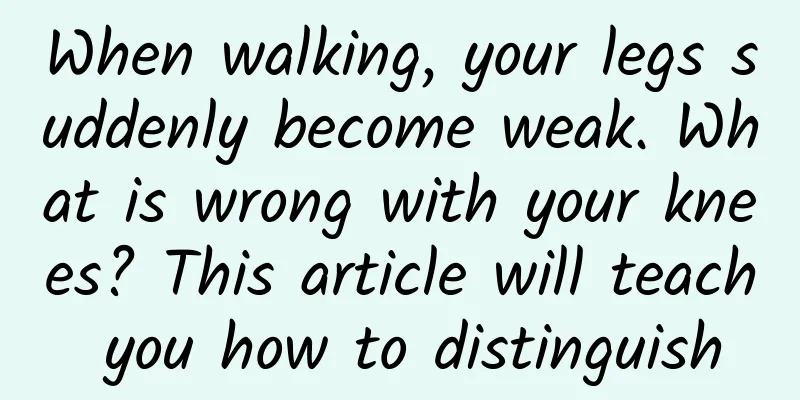When walking, your legs suddenly become weak. What is wrong with your knees? This article will teach you how to distinguish

|
Knee pain, usually no problem The part that can kill you if something goes wrong Many daily activities And invisibly add burden to it Until one day you go upstairs and your legs go weak You know you've been in trouble. Knee weakness There are many reasons It cannot be generalized when dealing with How to identify your knees What went wrong? Many people subconsciously think that knee discomfort, pain, and lack of strength are caused by calcium deficiency, but in fact, quite a few knee joint diseases will show similar symptoms in the early stages. Of course, there are many differences between them. Through these symptom differences, you can also make a preliminary judgment on your own situation: Symptom 1: Soreness and weakness in the knee joints, weakness in going up and down stairs, and obvious tenderness in the patella, around the patella, patellar margin, and behind the patella. It could be chondromalacia patella. Touch your knee and you will find the separate bone that looks like a lid - the patella. Image source: Photo Network There is a cartilage under the patella. Chondromalacia patellae refers to the degeneration and softening of this cartilage, which leads to symptoms such as knee pain and weak legs when walking. If the disease develops more seriously, the patient may not be able to stand on one leg and may become lame. Patellar chondromalacia is more common in middle-aged and elderly people, especially those with a history of knee trauma and chronic strain, who are much more likely to be affected. There are several types of people who are particularly susceptible to this disease: ● Obese people; ● People who often climb mountains or stairs, or whose jobs require long periods of squatting; ● People who lack exercise of lower limbs for a long time; ● Special occupations such as athletes and soldiers; Symptom 2: There is obvious swelling in the knee joint. It could be synovitis. The synovium is a thin membrane that covers the inner surface of the joint. Its main function is to secrete a small amount of synovial fluid to reduce friction on the joint surface. It also provides nutrients to the articular cartilage and excretes waste. Image source: Photo Network The knee joint is the joint with the most synovial tissue and the largest area, and is therefore the most common site of synovitis. After synovial disease, the secretion of joint fluid increases significantly, leading to knee joint effusion, so the main symptom of the patient is the swelling of the knee joint. Most patients will also have knee pain, but the severity of the pain may not be consistent with the degree of inflammation and swelling, and some people are completely painless. Image source: Photo Network There are many causes of synovitis, the most common of which include: ● Reactive synovitis caused by trauma, fatigue, or infection in adjacent areas; ● Degenerative osteoarthritis combined with synovitis; ● Synovitis caused by autoimmune diseases (rheumatoid arthritis, systemic lupus erythematosus, ankylosing spondylitis, psoriasis); ●Infectious synovitis caused by bacteria, mycoplasma, and tuberculosis; ●Others include synovitis caused by metabolic diseases (gout), blood diseases (hemophilia), hereditary diseases (pachydermoperiostosis), as well as pigmented villonodular synovitis and rice body synovitis that are specific to the synovium. Symptom 3: The pain in the early stage is intermittent. The pain will be aggravated when the temperature drops or on rainy days. The knee joints will be painful and stiff when getting up in the morning or after sitting for a long time, and will improve slightly after activity. It may be bone hyperplasia. Many people also call this disease "bone spurs", which is medically known as bone degenerative changes. Image source: Photo Network In fact, patients with this disease begin to experience degenerative changes in their joints at around the age of 26, and the incidence rate can be as high as 90% by around the age of 40. Generally speaking, there are three causes of bone hyperplasia: ● With age, the periosteum of the joint degenerates, ruptures and partial detachment occurs, and after a period of ossification, thorn-like protrusions are formed; ● The ligaments of middle-aged and elderly people are loose, the muscle strength is reduced, the joint stability is poor, and the protruding cartilage around the joints becomes pointed and forms bone spurs; ● When the joints are traumatized or deformed, the joint surfaces are subjected to uneven forces, which interact with each other to cause the bone surfaces to become rough and hairy, thus causing bone hyperplasia. In addition to knee joint disease These diseases should also be noted Weak knees are not always caused by problems with the knee joints; they may also be indirectly caused by physical illnesses in other parts of the body. For example, middle-aged and elderly people may also experience limb weakness, frailty, and unsteady standing due to cerebrovascular diseases. Most of the time, diseases such as cerebral infarction lead to insufficient blood supply to the brain, thus affecting the body's balance. Image source: Photo Network In addition, there is a certain chance that lumbar disc herniation will compress the nerves, which can also lead to symptoms such as lower limb weakness and lower limb muscle atrophy. The knee is like a transmission shaft in the human body Essential for everyone Once damage occurs This will have a serious impact on our daily activities. Protecting your knees is not a one-day job. We need to pay more attention to it in our daily life Be kind to your knees every day Statement: This article is a medical-related educational popular science article. It does not involve specific treatment methods or medical behaviors and cannot replace hospital visits. Content Production Editor: Zhang Fuyao Map: Eastern Zhou Dynasty |
<<: The moon will welcome three "little friends" intensively, each with its own highlights
Recommend
Nuozadu: A milestone project of China's earth-rock dam
Catching up with the 10th anniversary of the powe...
Does dragon blood in the Muggle world really have twelve uses?
As we all know, the only known paper by Professor...
Sony: There are a large number of "defectors" among PS4 players
Sony's PS4 game console has sold more than 7 m...
The veteran in door-to-door sales will tell you: You can do door-to-door sales well without any gifts!
At present, many ground-based promotion activitie...
What are the consequences if Pinduoduo’s main category is wrong? How many categories can you focus on?
When opening a Pinduoduo store, you list your pro...
Operational strategies for low-cost customer acquisition in the education industry!
During the epidemic, after experiencing low conve...
The official version of iOS 14.5 is finally here! More than a dozen new features are quite practical
Hello friends, after 8 Beta versions and 1 RC ver...
How programmers can quickly recover from "professional burnout"
[[152521]] Programmers' work is stressful, fa...
The most commonly used Windows download software is broken? There are 7 tools to help you solve the download problem
Once upon a time, downloading was a very simple t...
Is “Turning Stone into Gold” a delusion? It works in the desert!
Produced by: Science Popularization China Author:...
The discovery of the battery was an accident
Batteries are indispensable in our daily lives, b...
Why is information flow so popular nowadays? What kind of advertising will dominate the future?
Explore the past, present and future of Internet ...
Table tennis teaching course video collection
Course Catalog: ├──05-shakehandloop-attack.mp4 1....
A tough guy DIYs a powered exoskeleton and can lift 77 kg with ease
DIY madman The Hacksmith has done something extra...









